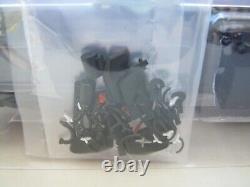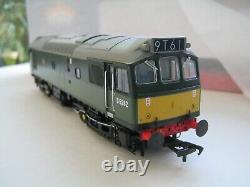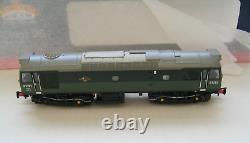Bachmann 32-341 Class 25 /2 No. D5282 BR Plux 22 DCC Ready Brand New OO Gauge



















For sale a Bachmann Ref No. 32-341 BR Class 25/2 No. D5282 in Two Tone Green Livery with small yellow Warning Panels. This is the Plux22 DCC Ready Version (not fitted) New tooling. The model comes in a Brand New condition with sealed detail pack and maintenance instructions. The Class 25 Diesel Locomotive has long been a fixture of the Bachmann Branchline OO scale range, but this all-new model owes nothing to its predecessors. Designed from the rails up, this new family Class 25s from Bachmann Branchline encompasses Class 25/1s, 25/2s and 25/3s, capturing the differences - some small, some anything but - between the three distinct types. Regardless of the particular locomotive being depicted, every model features high fidelity mouldings and numerous separately fitted parts, with the utmost attention to detail paid to the features of the prototype. Our new Class 25 is brought to life with an exquisite livery application using true-to-prototype colours, fonts and logos. Following the precedent set by the Bachmann Branchline Class 47, and subsequently the 37 and 31 too, the Class 25 features a full lighting suite and is available in three formats; this standard model. With a pre-fitted DCC Sound Decoder, or. With the award winning motorised radiator fan and authentic tinted windscreen glazing features! Pristine BR Two-Tone Green (Small Yellow Panels) livery.
Equipped with a Plux22 DCC Decoder Socket. DETAIL VARIATIONS SPECIFIC TO THIS MODEL. Late Body with Cantrail Grilles - Class 25/2. Glazed Headcode Panels - displaying Blinds 1T38 and 9T61. Plated Bodyside Water Filler Door.
BACHMANN BRANCHLINE CLASS 25 SPECIFICATION. Five pole, twin shaft motor with two flywheels providing drive to both bogies. Separate metal bearings fitted to each axle.
Diecast metal chassis block and bogie towers. Diecast metal gearboxes, with gearing arranged for prototypical running speeds and haulage capabilities.5mm (OO gauge) wheels to NEM310 & NEM311 standards with authentic profile and detailing. Detachable coupling pockets to NEM362 standards fitted to each bogie. Designed to operate on curves of second radius (438mm) or greater. Bogies constructed from multiple components featuring full relief detail. Rotating radiator fan, driven by an independent motor and gearbox, operated as part of the sound project on DCC and Analogue control.
Tinted windscreen glazing Driver and Second Man windscreens only as per the prototype. Separately applied metal detail parts, including grab handles, windscreen wipers and etched radiator grilles.Cab interior detailing which includes the control desk, seats and ancillary equipment, all with era-specific decoration. Each model supplied with a full set of decorated, model-specific bufferbeam pipework and accessory parts including three-piece, body-mounted snow ploughs where appropriate. Directional lighting, including illuminated headcode panels, switchable on/off at either end on DCC or Analogue control. Cab lighting, assigned to two DCC functions for separate switching of each.
Separately switched Engine Room lighting (when used on DCC). Authentic light colours and temperatures selected for each model based on era and application. A quality speaker employed for optimum sound reproduction, fitted to every model as standard. Zimo MS450P22 DCC Sound Decoder fitted to. Sound files produced specifically for the Bachmann Branchline Class 25 using recordings from real locomotives.Models operate on DCC and Analogue control as supplied. On Analogue, an authentic engine start up sequence and running sounds are produced when power is applied. Authentic liveries applied to all models. Multiple paint applications employed on each model using BR and corporate specification colours. Logos, numerals and text added as appropriate using multi-stage tampo printing using authentic typefaces, logos and colours.
In addition, where applicable Etched Nameplates are also provided. Following publication of the British Railways Modernization Plan in 1955, the British Rail Class 25 diesels were introduced into service in 1961 and were more powerful than the Class 24 Bo-Bo diesels introduced three years earlier. A total of 325 Class 25 Diesel Locomotives over several sub-types were built, most at BR Derby, but some were constructed at Crewe and Darlington with a further 26 built by Beyer Peacock of Manchester.As Type 2 locomotives, the Class 25s were often seen working in pairs to increase operational power. Although not allocated to the Southern Region, they were often seen on incoming and through traffic from the other regions.
With notable examples including the provision of train heating for steam hauled specials in their swansong years. The Class was finally withdrawn from service in 1987, but twenty preserved locomotives survive to the present day.

